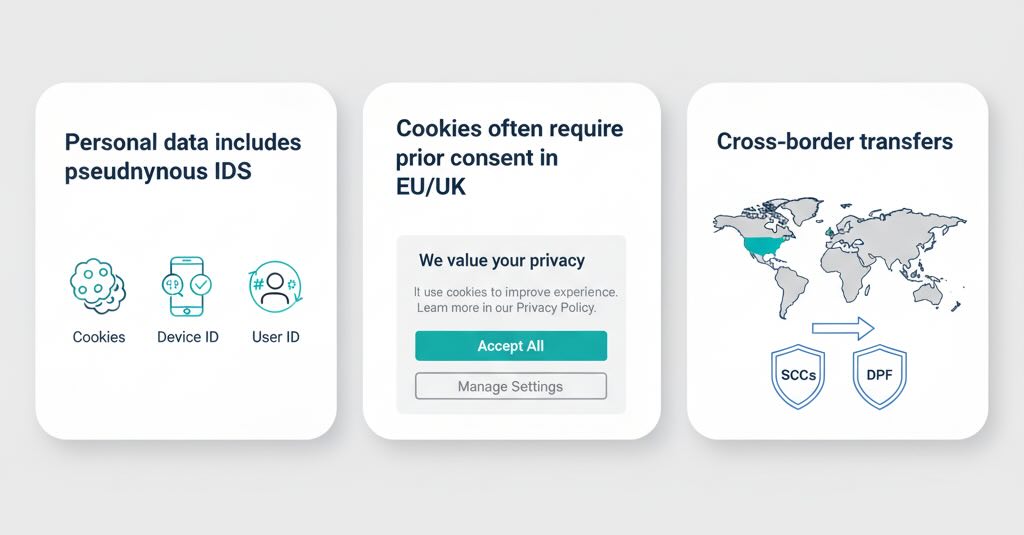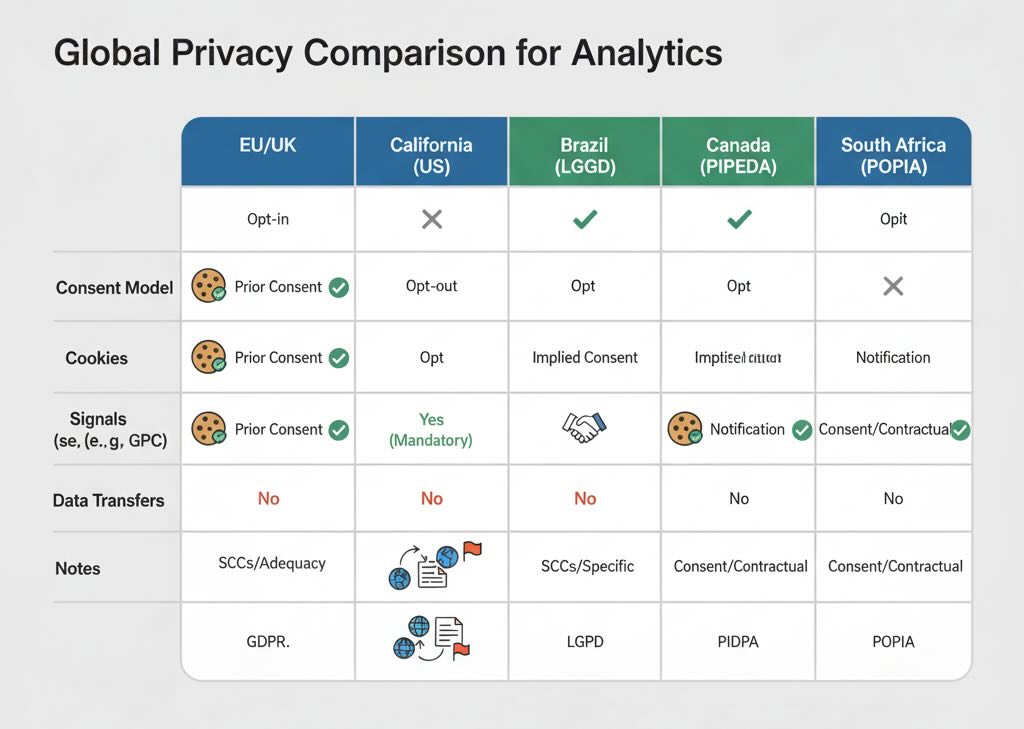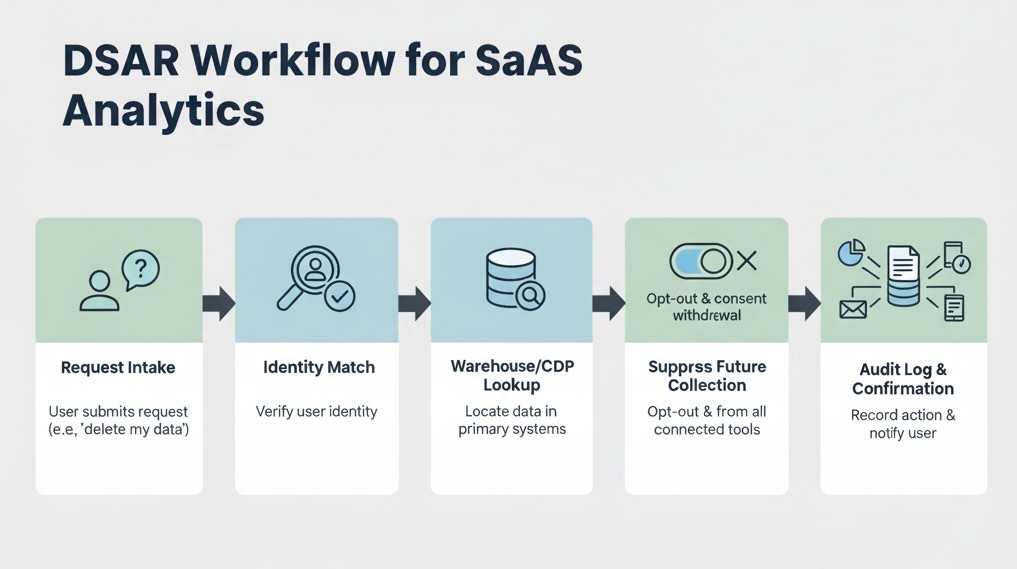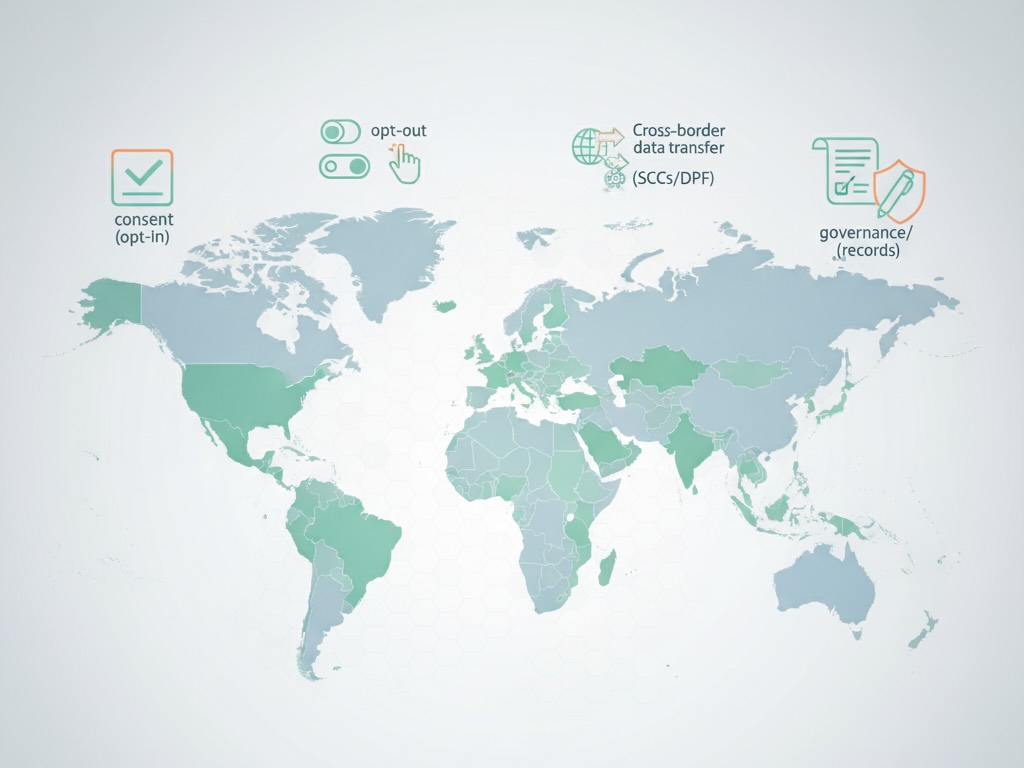Modern analytics lives under a patchwork of privacy laws. If you run product analytics, attribution, or experimentation across markets, you’re balancing consent, opt-out signals, data-transfer rules, and record-keeping—often all at once. This guide maps the essentials and shows how to keep insight flowing without stepping on regulatory landmines.
First principles that shape analytics
- Personal data is broad. Pseudonymous IDs (cookies, device IDs, user IDs) are still “personal data” under the GDPR, which means you need a lawful basis to process them. pdpc.gov.sg
- Cookies and similar tech often require consent in the EU/UK. The ePrivacy Directive (and UK PECR) governs cookies; most analytics cookies are not “strictly necessary,” so a prior, informed opt-in is expected. See the UK regulator’s cookie guidance for practical detail.
- Cross-border transfers add extra duties. If EU/UK data goes to the U.S. or elsewhere, you typically need Standard Contractual Clauses or rely on the EU-U.S. Data Privacy Framework (where applicable).

Regional rundown (what analytics teams actually feel)
European Union (GDPR + ePrivacy)
- Legal bases: Consent is safest for client-side analytics/cookies; some teams assess legitimate interests for limited, privacy-friendly measurement, but beware local DPA views. The GDPR sets the baseline; cookies sit under the ePrivacy Directive.
- Transfers: Use Standard Contractual Clauses plus transfer risk assessments, or the EU-U.S. Data Privacy Framework for eligible U.S. recipients.
United Kingdom (UK GDPR + PECR)
- Rules: Functionally similar to the EU. The ICO states analytics cookies generally need consent; see its plain-English cookie guidance and the UK GDPR overview.
United States (California CCPA/CPRA)
- Core idea: Transparency and consumer control (opt-out of “sale” or “sharing” for cross-context behavioral advertising).
- Signals: The CPPA’s CPRA regulations require honoring opt-out preference signals. The AG’s Sephora action made clear that sites must respect the Global Privacy Control signal in practice.
Brazil (LGPD)
- Scope: GDPR-style principles (legal bases, data subject rights). See the law text of the LGPD and guidance from ANPD. Expect consent or another valid basis for analytics identifiers.
Canada (PIPEDA)
- Model: Reasonable purposes and meaningful consent are central. The OPC’s overview of PIPEDA explains expectations for commercial analytics and transparency.
Singapore (PDPA)
- Approach: Consent remains common, with targeted exceptions (including a legitimate-interests-like ground). PDPC’s comparison of PDPA vs GDPR is a helpful orientation for analytics teams.
South Africa (POPIA)
- Takeaway: POPIA mirrors many GDPR principles (lawfulness, minimality, security). See the regulator’s overview and forms under POPIA when planning analytics workflows.

What this means for your analytics stack
1) Consent and preference management
- EU/UK: Present a granular banner before dropping non-essential cookies, and log consent. ICO’s cookie guidance clarifies that analytics cookies usually aren’t “strictly necessary.”
- California: Provide “Do Not Sell or Share” and honor signals like Global Privacy Control. Validate that downstream tools also propagate the opt-out.
2) Minimize and localize data
- Collect only events you use. Hash or rotate user IDs, cap retention, and default to aggregated or modeled reporting where possible. When EU data leaves the EEA, attach Standard Contractual Clauses and document safeguards; use the EU-U.S. Data Privacy Framework where it fits.
3) Prefer first-party and server-side patterns
- First-party tagging and server-side collection reduce third-party exposure and make honoring consent/opt-out easier. This won’t remove obligations under the ePrivacy Directive or UK cookie guidance, but it narrows risk and simplifies vendor maps.
4) Build response muscle for data subject requests
- Across the GDPR, LGPD, PIPEDA, and POPIA, individuals can access or delete personal data. Ensure your CDP/warehouse can look up IDs, suppress collection when consent is withdrawn, and cascade deletions to downstream tools.
5) Bake governance into delivery
- Maintain a processing register (systems, data types, purposes, bases). Run DPIAs for high-risk profiling. Keep vendor DPAs current and align on roles (controller vs processor) per the UK GDPR guide and GDPR definitions.
A practical, region-aware checklist for analytics teams
- Consent banners: EU/UK use opt-in (no pre-ticked boxes). California offers opt-out; place the link prominently and respect Global Privacy Control.
- Tagging plan: Default to first-party tags and server-side routing; suppress all non-essential tags until consent.
- Data retention: Keep the shortest window that still supports your cohorting and LTV models; document it.
- Cross-border transfers: Attach Standard Contractual Clauses or rely on the EU-U.S. Data Privacy Framework where applicable; maintain transfer risk assessments.
- Rights handling: Test DSAR flows quarterly across warehouse, CDP, and downstream ad/analytics tools—cover access, deletion, and opt-out.
- Vendor oversight: Map every destination that receives identifiers; sign DPAs; verify sub-processors; align with PIPEDA and POPIA/LGPD where you operate.

The bottom line
Great analytics and strong privacy are not at odds. If you anchor your program in explicit consent where required, minimize identifiers, honor opt-out signals, and document cross-border safeguards, you can ship trustworthy insights—globally.
Referenced primary sources for deeper reading: the GDPR, ePrivacy Directive, UK GDPR guide & cookie guidance, CPRA regulations and California AG’s Global Privacy Control enforcement, the EU’s Standard Contractual Clauses and EU-U.S. Data Privacy Framework, plus national laws LGPD, PIPEDA, and POPIA.

